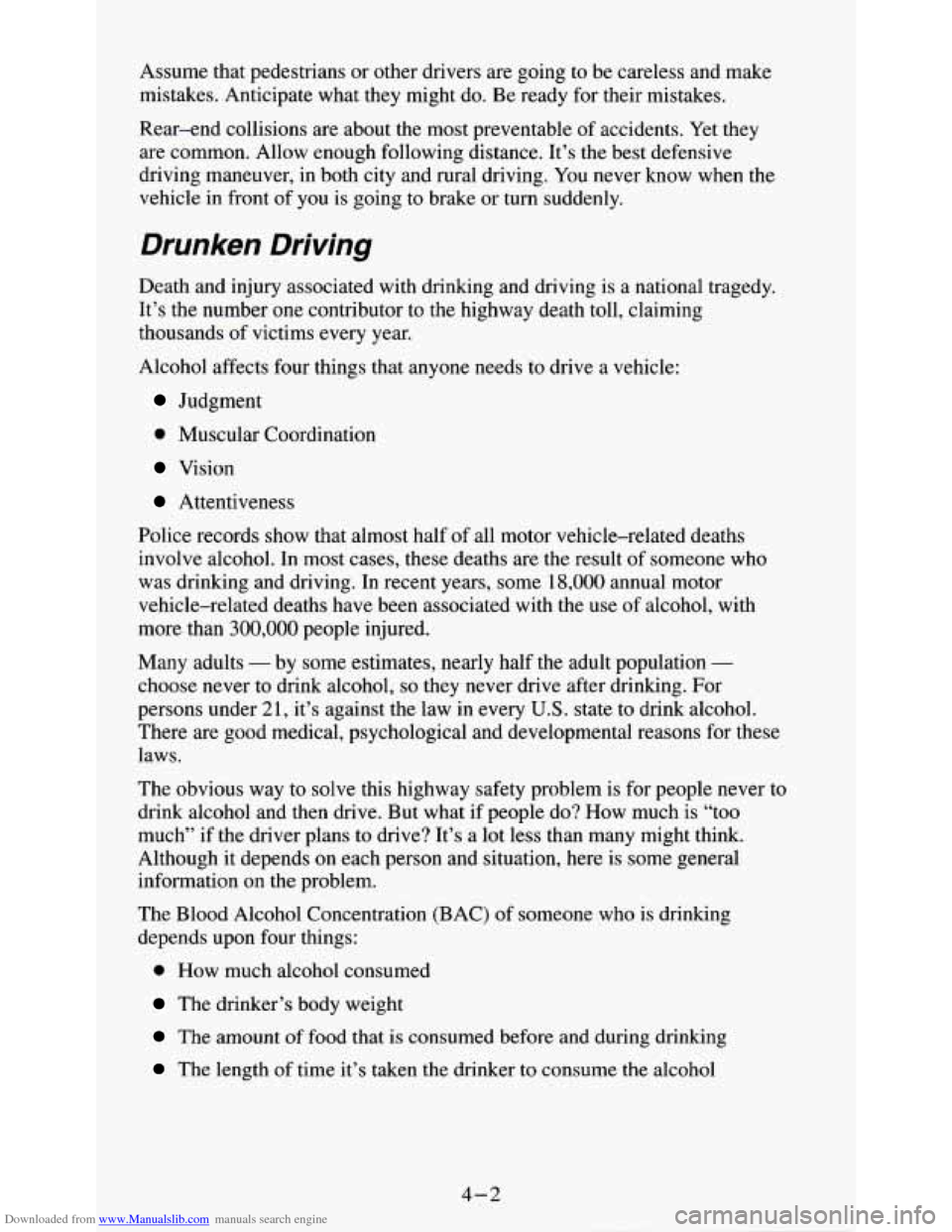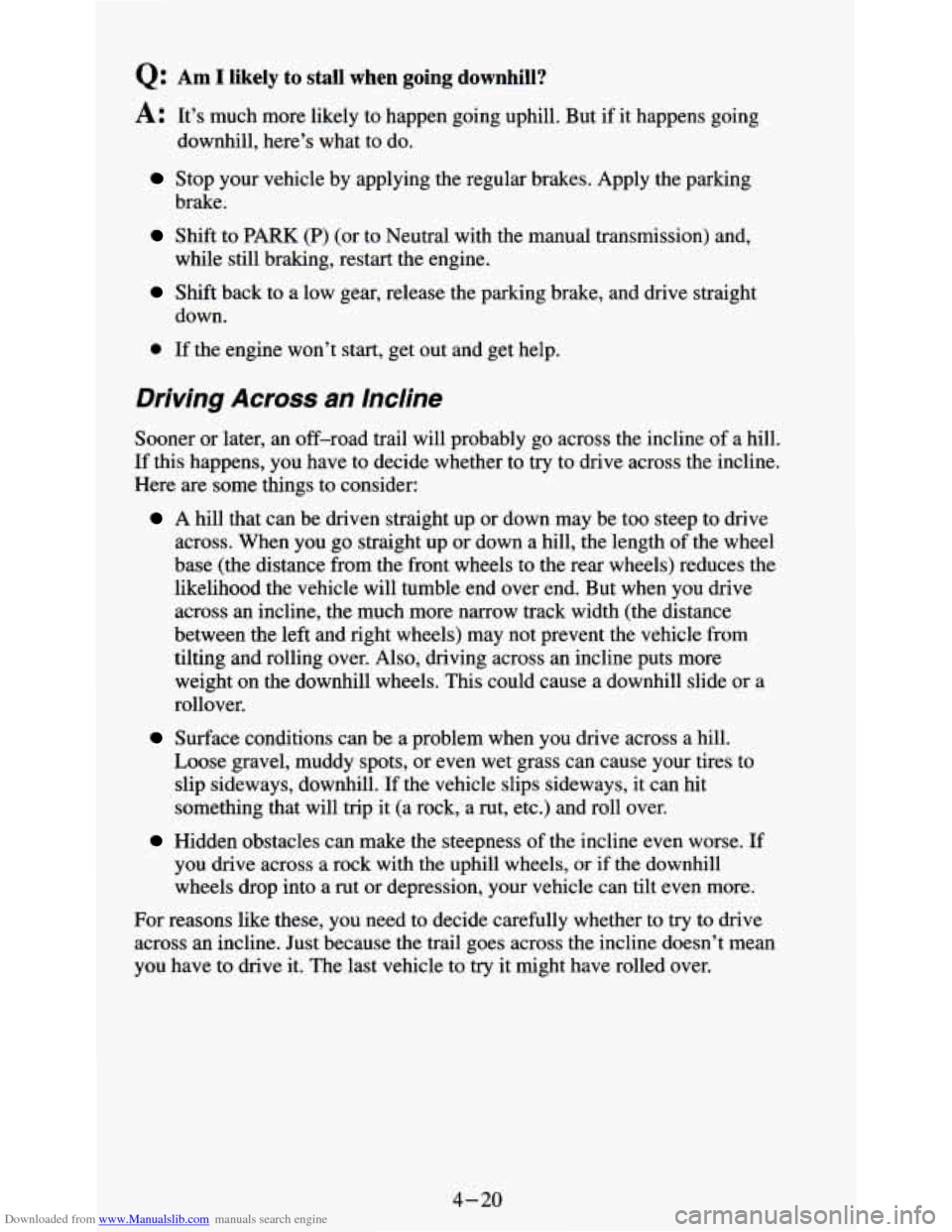Page 135 of 354

Downloaded from www.Manualslib.com manuals search engine Assume that pedestrians or other drivers are going to be careless and make
mistakes. Anticipate what they might do. Be ready for their mistakes.
Rear-end collisions are about the most preventable of accidents. Yet they
are common. Allow enough following distance. It’s the best defensive
driving maneuver, in both city and rural driving. You never know when the
vehicle in front of you is going
to brake or turn suddenly.
Drunken Driving
Death and injury associated with drinking and driving is a national tragedy.
It’s the number one contributor to the highway death toll, claiming
thousands of victims every year.
Alcohol affects four things that anyone needs to drive a vehicle:
Judgment
0 Muscular Coordination
Vision
Attentiveness
Police records show that almost half of all motor vehicle-related deaths
involve alcohol. In most cases, these deaths are the result
of someone who
was drinking and driving. In recent years, some
18,000 annual motor
vehicle-related deaths have been associated with the
use of alcohol, with
more than
300,000 people injured.
Many adults
- by some estimates, nearly half the adult population -
choose never to drink alcohol, so they never drive after drinking. For
persons under
21, it’s against the law in every U.S. state to drink alcohol.
There are good medical, psychological and developmental reasons for these
laws.
The obvious way to solve this highway safety problem is for people never to
drink alcohol and then drive. But what if people do? How much is “too
much” if the driver plans to drive? It’s a lot less than many might think.
Although it depends on each person and situation, here is some general
information on the problem.
The Blood Alcohol Concentration (BAC)
of someone who is drinking
depends upon four things:
0 How much alcohol consumed
The drinker’s body weight
The amount of food that is consumed before and during drinking
The length of time it’s taken the drinker to consume the alcohol
4-2
Page 153 of 354

Downloaded from www.Manualslib.com manuals search engine Q: Am I likely to stall when going downhill?
A: It’s much more likely to happen going uphill. But if it happens going
downhill, here’s what to do.
Stop your vehicle by applying the regular brakes. Apply the parking
brake.
Shift to PARK (P) (or to Neutral with the manual transmission) and,
while still braking, restart the engine.
Shift back to a low gear, release the parking brake, and drive straight
down.
0 If the engine won’t start, get out and get help.
Driving Across an lncline
Sooner or later, an off-road trail will probably go across the incline of a hill.
If this happens, you have to decide whether to
try to drive across the incline.
Here are some things to consider:
A hill that can be driven straight up or down may be too steep to drive
across. When you go straight up or down a hill, the length of the wheel
base (the distance from the front wheels to the rear wheels) reduces the
likelihood the vehicle will tumble end over end. But when you drive
across an incline, the much more narrow track width (the distance
between the left and right wheels) may not prevent the vehicle from
tilting and rolling over. Also, driving across an incline puts more
weight on the downhill wheels. This could cause a downhill slide or a
rollover.
Surface conditions can be a problem when you drive across a hill.
Loose gravel, muddy spots, or even wet grass can cause your tires to
slip sideways, downhill. If the vehicle slips sideways, it can hit
something that will trip it (a rock,
a rut, etc.) and roll over.
Hidden obstacles can make the steepness of the incline even worse. If
you drive across a rock with the uphill wheels, or if the downhill
wheels drop into a rut or depression, your vehicle can tilt even more.
For reasons like these, you need to decide carefully whether
to try to drive
across an incline. Just because the trail goes across the incline doesn’t mean
you have to drive it. The last vehicle to try it might have rolled over.
4-20
Page 171 of 354

Downloaded from www.Manualslib.com manuals search engine There’s also important loading information for off-road driving in this
manual. See “Loading Your Vehicle”
in the Index.
Two-Tiered Loading
By positioning four 2” x 6” wooden planks across the width of the pickup
box,
you can create an upper load platform. The planks must be inserted in
the pickup box depressions. The length
of the planks must allow for at least
3/4“ bearing surface on each end of the plank.
When using this upper load platform, be sure the load
is securely tied down
to prevent it from shifting. The load’s center of gravity should be positioned
in a zone over the rear axle. The zone is located in the area between the
front
of each fenderwell and the rear of each fenderwell. The center of
gravity height must
not extend above the top of the pickup box flareboard.
Any load that extends beyond the vehicle’s taillamp area must be properly
marked according to local laws and regulations.
Remember
not to exceed the Gross Axle Weight Rating (GAWR) of the rear
axle. See “Loading Your Vehicle”
in the Index.
Payload
The Payload Capacity is shown on the CertificatiodTire label. This is the
maximum load capacity that your vehicle can carry. Be sure to include
the
weight of the people inside as part of your load. If you added any
accessories or equipment after your vehicle
left the factory, remember to
subtract the weight
of these things from the payload. Your dealer can help
you with
this.
4-38